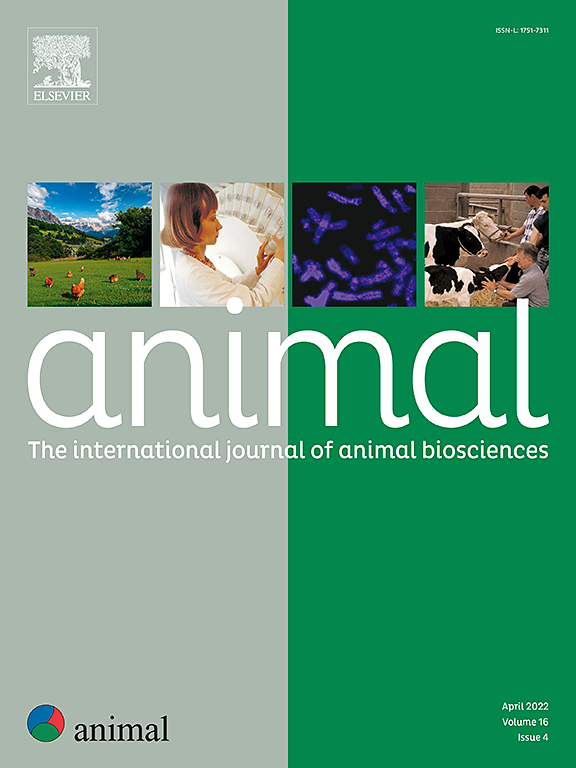黑翅大实蝇幼虫发育和取食基质过程中的淀粉酶活性:对淀粉消化率和外部消化的启示。
IF 4
2区 农林科学
Q1 AGRICULTURE, DAIRY & ANIMAL SCIENCE
引用次数: 0
摘要
黑兵蝇幼虫(BSFL;Hermetia illucens)有望将生物废弃物转化为蛋白质和脂质作为饲料。幼虫能有效消化食物中的淀粉并影响幼虫的表现,但对淀粉的消化机制仍知之甚少。本研究调查了 BSFL 在饲喂 4、7 和 11 天后个体重量和淀粉酶活性的变化,这五种基质的淀粉含量和类型各不相同:鸡饲料(CF)、玉米麸质饲料(CGF)、麦麸(WB)、小麦蒸馏谷物(WDG)和废弃马铃薯(DP)。此外,还测量了幼虫(分别为饲喂盘和发酵盘)在一段时间内的底物淀粉酶活性,以探索外部消化情况。实验结束时评估了饲料转化率(FCR)以及 DM 和淀粉的估计消化率(ED)。最佳饲料转化率依次为 CF、WB、CGF、WDG 和 DP。在饲喂盘中,CF、DP、WB、CGF 和 WDG 的 DM 消化率分别为 69.8 ± 1.8、59.5 ± 2.9、58.6 ± 0.7、45.4 ± 0.6 和 19.5 ± 0.8%。WB和CGF的淀粉估计消化率达到100%,其次是CF(88.2 ± 2.3%)、DP(85.2 ± 1.2%)和WDG(43.1 ± 1.0%)。在所有基质中,幼虫淀粉酶活性随生长而增加,在接近化蛹时则下降。没有发现幼虫淀粉酶活性与基质淀粉或其他营养物质含量之间的关系,但报告称幼虫淀粉酶活性与还原糖含量呈负相关,表明葡萄糖抑制了淀粉酶的产生。除 WDG 和 DP 外,所有饲喂基质和发酵基质中的淀粉酶活性都会随着时间的推移而降低。体外降解试验表明,BSFL 淀粉酶在生玉米或小麦淀粉上的效率是生马铃薯淀粉的九倍,这突出表明淀粉结构是消化率的主要驱动因素。Western 印迹分析显示,饲喂基质中存在 BSFL 淀粉酶,这表明存在外部消化。对幼虫淀粉酶进行了纯化,以确定其最佳 pH 值(5.0-6.5)和温度(70 °C)。这些结果突出表明,淀粉含量并不是 BSFL 淀粉酶活性的主要驱动因素,并表明其他未调查的因素可能对幼虫消化酶的活性有至关重要的影响,如底物的微生物群落和淀粉酶抑制剂的存在。这项研究还有助于深入了解 BSFL 消化活性在其发育过程中的演变以及外部消化的发生。本文章由计算机程序翻译,如有差异,请以英文原文为准。
Amylase activity across black soldier fly larvae development and feeding substrates: insights on starch digestibility and external digestion
Black soldier fly larvae (BSFL; Hermetia illucens) hold promise for converting biowaste into proteins and lipids for feed. Dietary starch is efficiently digested by the larvae and influences larval performance, but the mechanisms of starch digestion remain poorly understood. This study investigated changes in individual weight and amylase activity in BSFL after 4, 7 and 11 days of feeding for five substrates varying in starch content and type: chicken feed (CF), corn gluten feed (CGF), wheat bran (WB), wheat distillers grain (WDG) and discarded potatoes (DP). Substrate amylase activities were also measured with and without larvae (feeding and fermenting trays, respectively) over time in order to explore external digestion. Feed conversion ratio (FCR) and estimated digestibility (ED) of DM and starch were assessed at the end of the experiment. The ranking for best FCR was CF, WB, CGF, WDG and DP. In feeding trays, ED of DM was 69.8 ± 1.8, 59.5 ± 2.9, 58.6 ± 0.7, 45.4 ± 0.6 and 19.5 ± 0.8% in CF, DP, WB, CGF and WDG, respectively. Estimated digestibility of starch reached 100% with WB and CGF, followed by CF (88.2 ± 2.3%), DP (85.2 ± 1.2%) and WDG (43.1 ± 1.0%). Larval amylase activity increased with growth for all substrates and dropped when approaching pupation. No relationship was found between larval amylase activity and substrate starch or other nutrient content, but a negative correlation was reported with the reducing sugar content of the larvae, suggesting glucose repression of amylase production. Amylase activity decreased with time in all feeding and fermenting substrates except WDG and DP. In vitro degradation assays indicated that BSFL amylase was nine times more efficient on raw corn or wheat starch than on raw potato starch, highlighting that starch structure is a major driver of digestibility. Western blot analysis revealed the presence of BSFL amylase in the feeding substrate, hinting at external digestion. Larval amylase was purified to identify its optimal pH (5.0–6.5) and temperature (70 °C). These results highlight that starch content is not a major driver of amylase activity in BSFL and suggest that other non-investigated factors could have had a crucial impact on the activity of larval digestive enzymes, such as microbial community of the substrate and presence of amylase inhibitors. This study also provides insights into the evolution of BSFL digestive activity during their development and the occurrence of external digestion.
求助全文
通过发布文献求助,成功后即可免费获取论文全文。
去求助
来源期刊

Animal
农林科学-奶制品与动物科学
CiteScore
7.50
自引率
2.80%
发文量
246
审稿时长
3 months
期刊介绍:
Editorial board
animal attracts the best research in animal biology and animal systems from across the spectrum of the agricultural, biomedical, and environmental sciences. It is the central element in an exciting collaboration between the British Society of Animal Science (BSAS), Institut National de la Recherche Agronomique (INRA) and the European Federation of Animal Science (EAAP) and represents a merging of three scientific journals: Animal Science; Animal Research; Reproduction, Nutrition, Development. animal publishes original cutting-edge research, ''hot'' topics and horizon-scanning reviews on animal-related aspects of the life sciences at the molecular, cellular, organ, whole animal and production system levels. The main subject areas include: breeding and genetics; nutrition; physiology and functional biology of systems; behaviour, health and welfare; farming systems, environmental impact and climate change; product quality, human health and well-being. Animal models and papers dealing with the integration of research between these topics and their impact on the environment and people are particularly welcome.
 求助内容:
求助内容: 应助结果提醒方式:
应助结果提醒方式:


